Sweet and slightly exotic, Turkish delight is a popular Middle Eastern candy that can be made and flavored in a variety of ways. Learn how to make it at home and customize it to suit your taste.
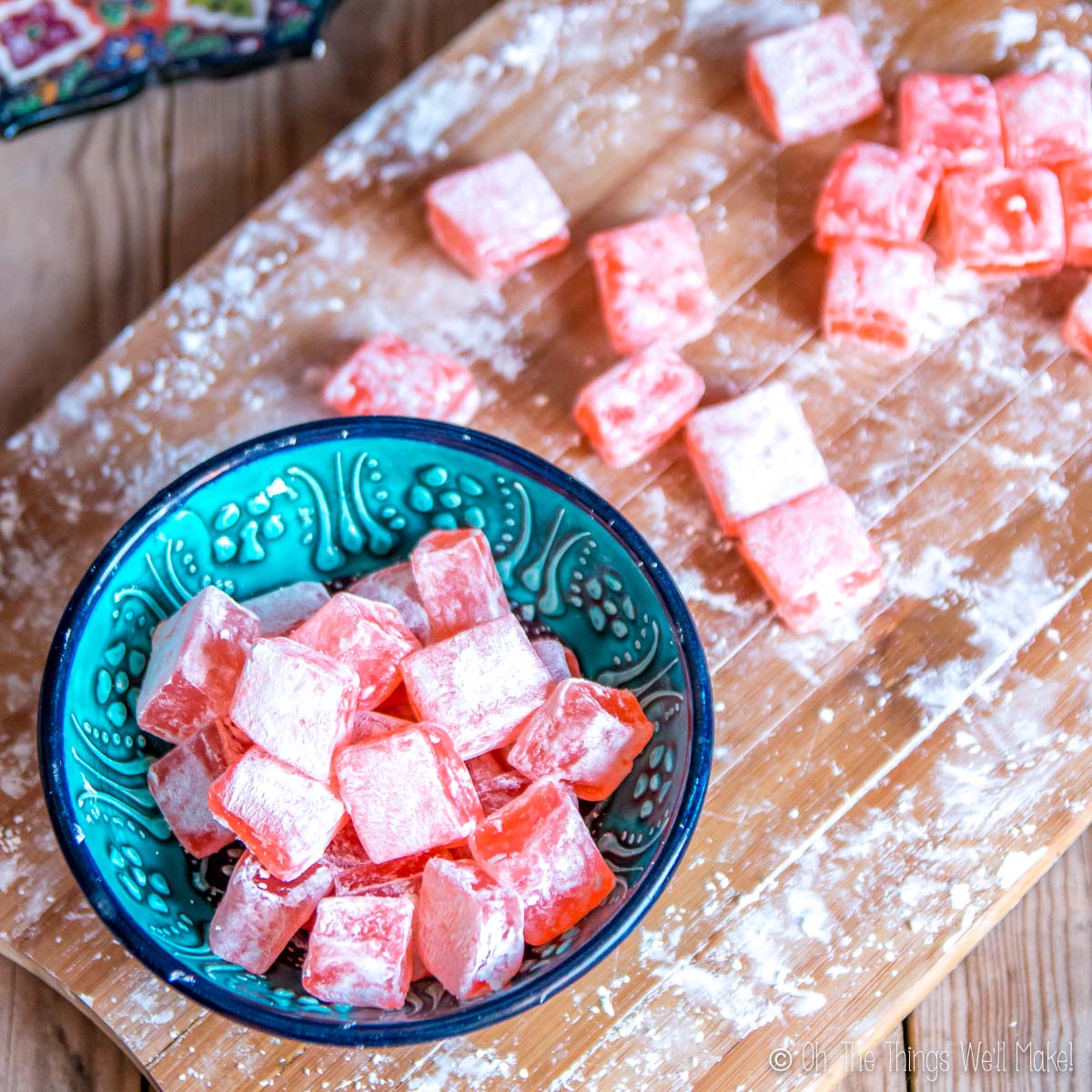
Several years ago, our family went on a European cruise that brought us to Italy, Croatia, Greece, and Kusadasi, Turkey. Of course, when cruising, you only make short stops in touristy areas. So, of course, I do not proclaim myself an expert in anything Turkish.
While I was there, though, rather than picking up an “authentic fake watch” (Yes, that was on a sign I saw!), I bought two beautiful hand-painted bowls and several boxes of Turkish delight.
What is Turkish delight?
Turkish delight, also traditionally known as lokum, is a sweet gel confection made with sugar and starch. It can be flavored in a number of ways, often with nuts, citrus fruits, and/or rose water. The most common is probably the pink-colored rose-flavored lokum, but other popular varieties use pistachios and walnuts. It’s very popular in the Middle East but has gained popularity in other parts of the world.
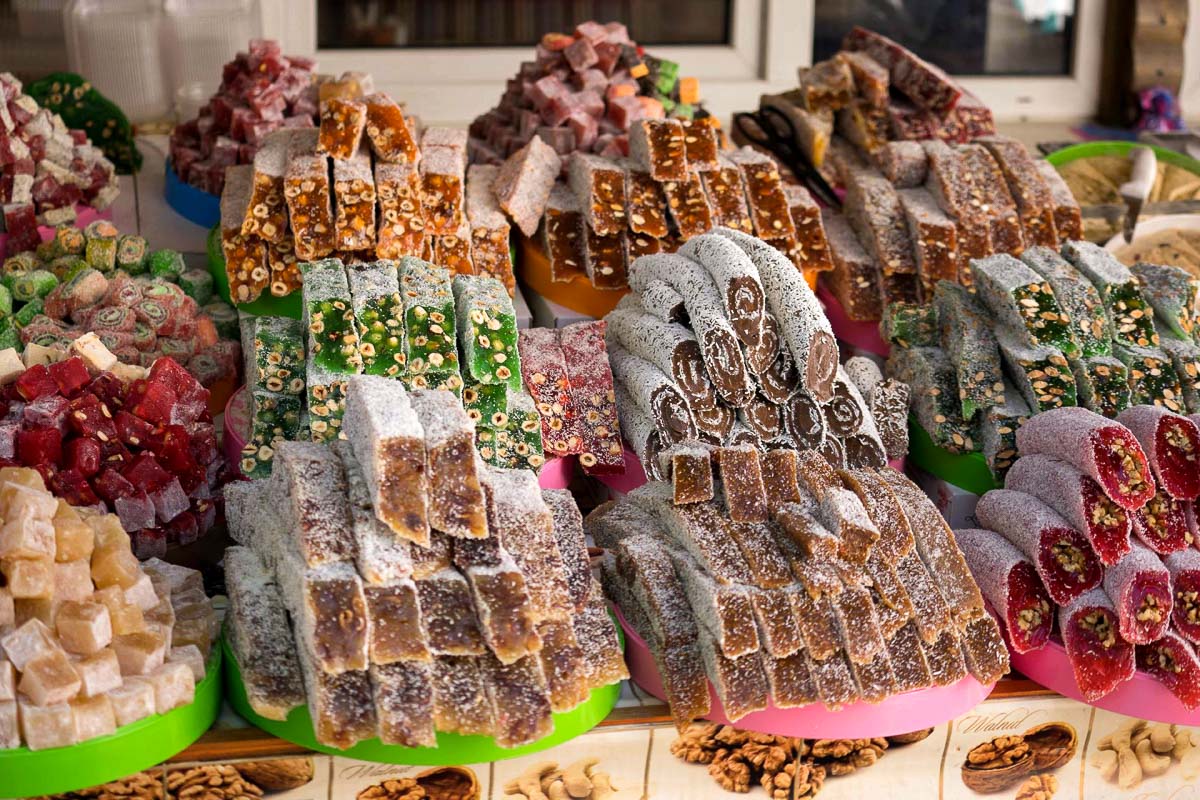
This gel-based sweet has piqued my interest ever since I watched an animated movie of The Lion, The Witch, and the Wardrobe (from the Chronicles of Narnia) at my grandparents’ house as a kid. In the story, the white witch lures young Edmund Pevensie with this delectable treat. His love of Turkish delight was enough to get him to betray his family and join her.
With my love of trying new things, especially anything exotic or with a “perfumed” type flavor (like litchees or roses), I knew I had to give it a try.
What does it taste like?
I suspected that I would like Turkish delight, but wasn’t prepared for how much I would like it. Normally, I don’t eat a lot of sweets. In fact, I really only have a hard time passing on licorice and its chewy texture.
With my first bite of rose-flavored Turkish delight, though, I was immediately taken in by its exotic flavors combined with that chewy texture that I adore. Unfortunately, the boxes I had bought were a bit deceiving. They were quite large but were well padded. I was a bit disappointed to find that I had really only brought back a few pieces of this new treat I loved so much.
The other variety I bought was more like a nougat with peanuts and pistachios. Both were delicious.
Making a traditional Turkish delight
So, I was determined to learn to make Turkish delight from scratch at home. After seeing numerous recipes, I figured making it must be easy. Unfortunately, after numerous attempts, I wasn’t completely happy with the outcome. I ended up with a sweet treat with a delicious rose flavor, but felt that it lacked a bit of chewiness.
Traditional Turkish delight is made with a starch and sugar. You have to play with the gelling of the starch and the hardening of the sugar mixture to get the right texture. (In contrast, some modern versions use gelatin or a similar gelling agent to achieve its characteristic chewiness.) While my boxes of Turkish delight had corn starch as the main starch used, I imagine that the truly traditional versions of this treat called for other starches instead.
When I published my first Turkish delight recipe on this blog, I used corn starch (as most recipes do) and avoided adding wheat because I was testing out a gluten-free diet at the time. (Wheat flour was on the list of ingredients of the lokum I had bought.)
Many people enjoyed the recipe, but I still wasn’t happy. I didn’t get consistent results with the recipe and found it to be finicky. I also wasn’t sure about the texture achieved with corn starch alone.
What didn’t work
While my first attempts resulted in a flavor that was spot-on, the texture was a lot lighter and softer, not at all chewy like the Turkish delight I had bought in Turkey. So, I tried numerous times to get it right.
I’m almost embarrassed to say how many times I have tried to make this.
Experimenting with the texture
When you rely on the cornstarch to thicken the candy, you end up with a semi-solid mass of candy, but it is more like a solid gel and not at all chewy. On the other hand, a chewy candy such as taffy is made by achieving a certain temperature with a mixture of sugar and water. So, I decided to experiment using different temperatures for the sugar and water mixture.
During my first attempts, I brought the sugar to 240ºF, just above the point where the sugar is inverted (more on that in a sec), and then added in the cornstarch solution. I ended up with a rose-flavored jelly treat that wasn’t at all chewy. It was sort of gelatinous in texture (although that doesn’t really describe it well either).
I then tried heating the sugar solution to the hardball stage before adding in the cornstarch solution. The result? A chewy Turkish delight that wasn’t so powerfully sweet, but with a caramelized sugar flavor reminiscent of flan.
The challenge was to get something in between.
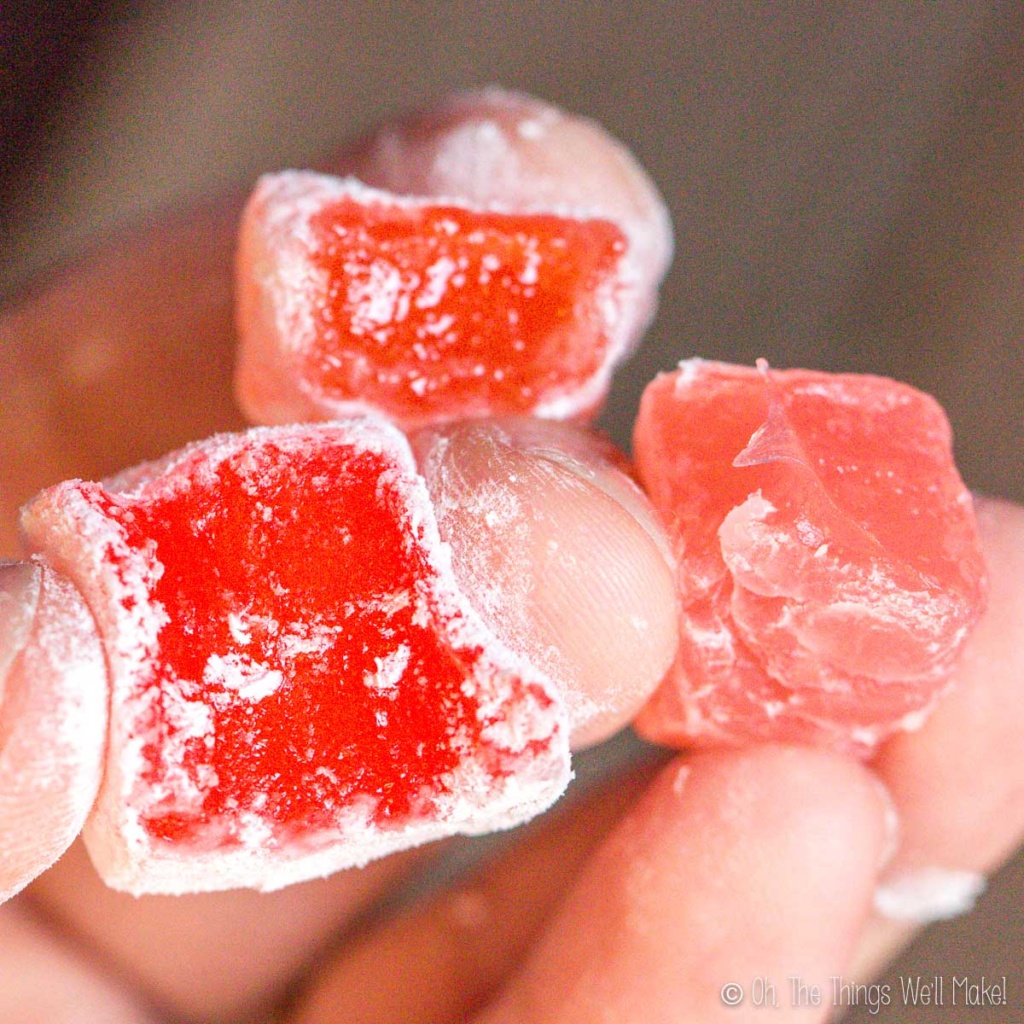
Comparing the textures of the store bought Turkish delight (left, bottom) to a softer, early attempt (right, bottom) and a chewier version (top) 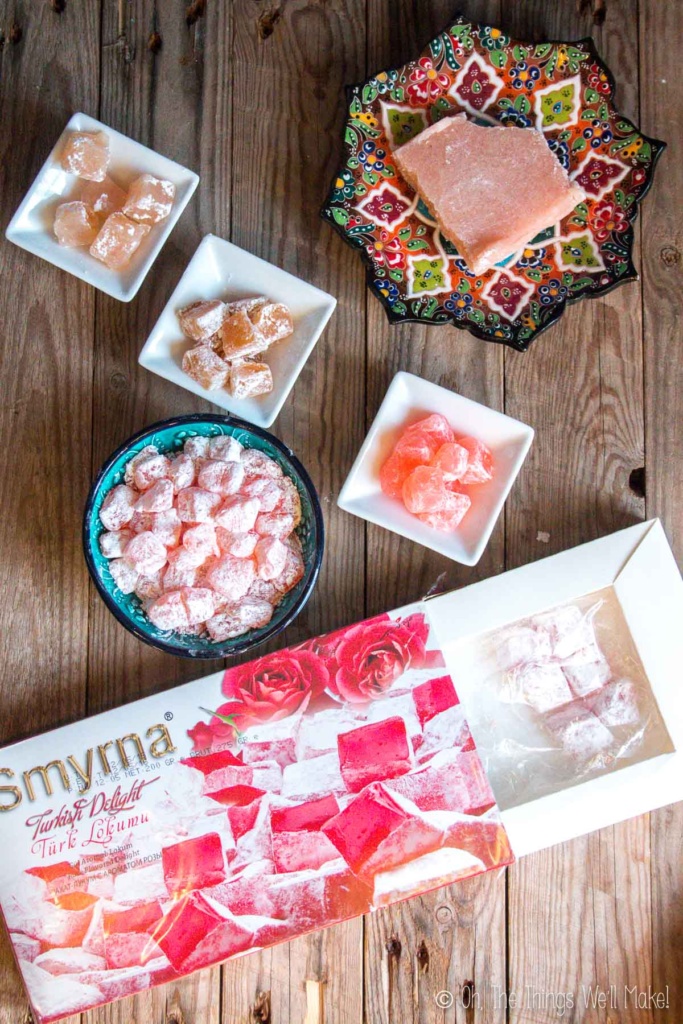
Various attempts at Turkish delight by the boxed candy I bought in Turkey. 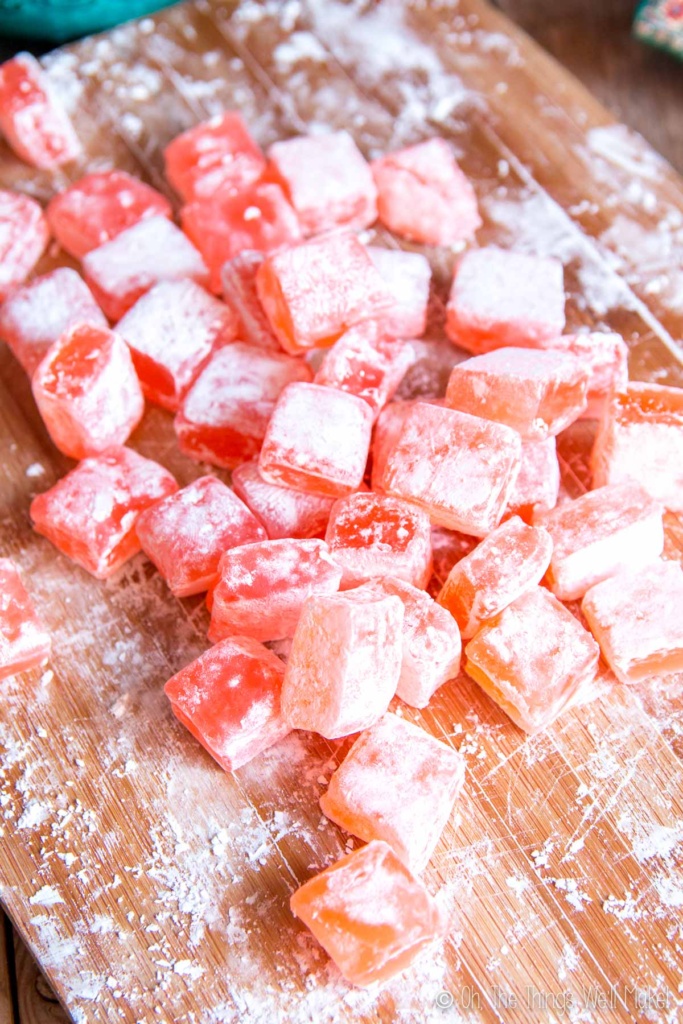
Two versions of homemade Turkish delight
In my first published recipe, I settled on heating the syrup to 260ºF. (Even at that temperature, though, the candy can take on a more caramelized flavor.)
Unfortunately, with that first recipe, I found there was a lot of room for error, even when following the recipe carefully and monitoring temperatures along the way. The final result depended on the cooking time, the humidity of the cooking space, etc.
I have since found that using other starches is the key to getting great texture without all of the hassle.
Adding the starch mixture
Many recipes online tell you to make a sugar syrup first and then make a separate paste out of the starch (normally cornstarch) and water. You are then supposed to mix everything together and cook the mixture longer. While I tried that method first, I didn’t see any benefit to making a separate paste out of only starch and water. It only made for difficult blending later on. Instead, I found it much easier to add an uncooked mixture of water and cornstarch to the sugar syrup and cook them together to thicken them.
From what I have read about Turkish delight production, it seems to be the usual way of making it anyway.
Adding the flavoring
Most recipes have you add the rosewater or other flavorings right before pouring the mixture into the mold, once you’ve achieved the desired consistency.
Adding flavorings such as rose water at the end, though, adds more moisture to the mixture. That, of course, inevitably changes the final texture, softening the candy. I’ve found that with my new recipe, it’s fine to add the rose water as part of the water used at the beginning. The flavor holds up quite well through the cooking process.
Another option? I found a recipe from a Turkish girl who flavored her Turkish delight with rose oil. While that sounds like a great solution, it’s also an expensive one for most of us.
Ingredients
So, after years of experimentation, I’ve finally found a recipe that I’ve been able to reproduce successfully several times now. The key to getting the texture and flavor I wanted was to use a different starch.
My first success used a 50/50 mixture of wheat flour and cornstarch. The wheat flour helped get a chewy texture that worked really well for this recipe. Still, it was tricky to cook it down enough to get the candy firm enough. (Those who’d like to give it a try, though, can substitute out half of the cornstarch in my original cornstarch-based recipe.)
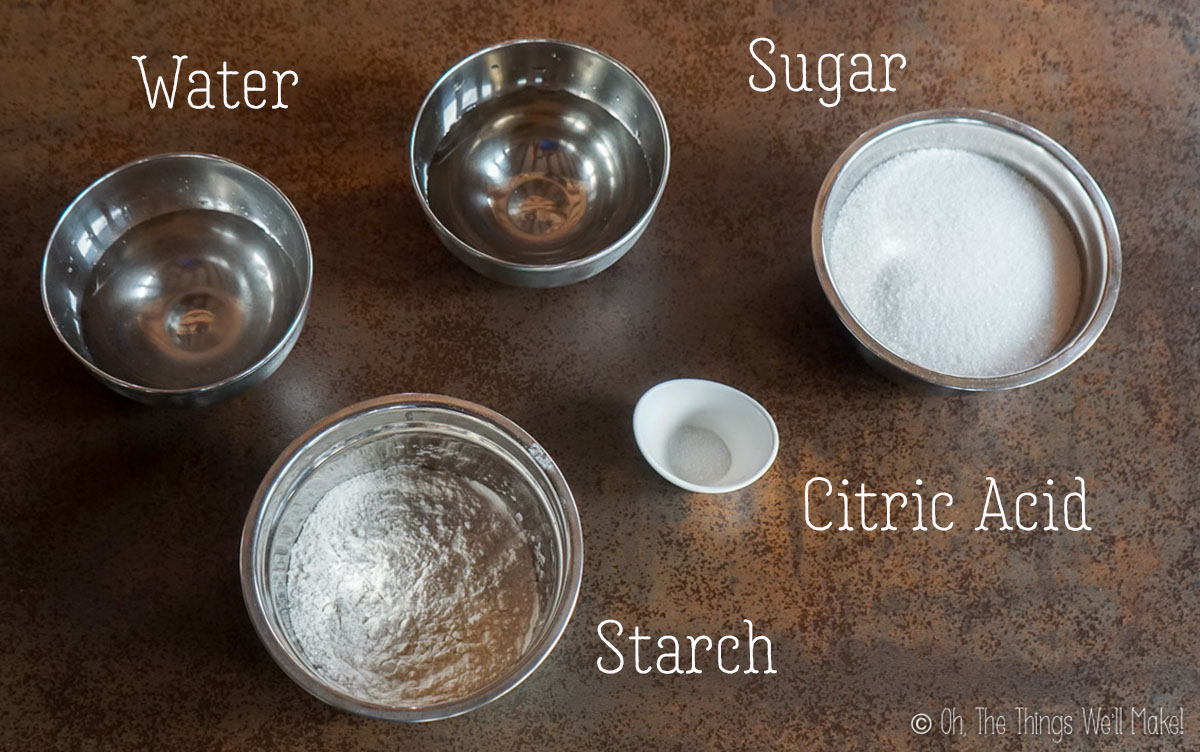
In the end, my favorite version uses rice flour instead of cornstarch.
Other than the rice flour, I used white sugar, water, and some citric acid. I flavored my candy with rosewater, but you can add other flavorings instead. If you want to make pink candy, you’ll also want to use some red food coloring. (On my first attempt, I used homemade beetroot powder and it worked quite well as a natural food coloring!)
Perhaps in the future I’ll try with other starches. I’d love to hear from those of you who have done that sort of experimentation!
Does it need cream of tartar?
Most recipes for Turkish delight use cream of tartar, many insisting that it’s very important for the recipe. My conclusion, after some investigation, is that the cream of tartar is only being used to acidulate the mixture. The sugar syrup you make at the beginning is also known as invert sugar. It helps keep your final candy from crystalizing.
As cream of tartar isn’t easily available in Spain (nor was it listed on my box of Turkish delight), I used citric acid instead. To make invert sugar you slowly cook the water, sugar, and citric acid (or cream of tartar) until you end up with a syrup around 236ºF. If you don’t have citric acid, you can also use lemon juice to bring down the pH.
Incidentally, some recipes added the cream of tartar to the cornstarch mixture rather than to the sugar syrup. I’m not really sure what they were intending to do, but I feel like they sort of missed the point of what the cream of tartar was actually meant to do.
Making Turkish Delight with Cornstarch
Before beginning, prepare the mold you plan on using. I used a small silicone mold greased with coconut oil. If you don’t have silicone pans, line a small baking pan with wax or parchment paper. (Consider greasing the paper with oil or butter to keep the candy from sticking to it.)
Mix together the sugar, water, and citric acid in a heavy bottom pan over medium to high heat. Bring the mixture to a slight boil before lowering the heat.
Continue to cook the mixture over low to medium heat until you reach 240ºF. While you shouldn’t stir the mixture throughout the process (as this can affect the temperature), you can occasionally use a spatula to wipe down any sugar crystals from the side of the pan.
As the sugar syrup cooks, mix together the cornstarch, water, and rose water.
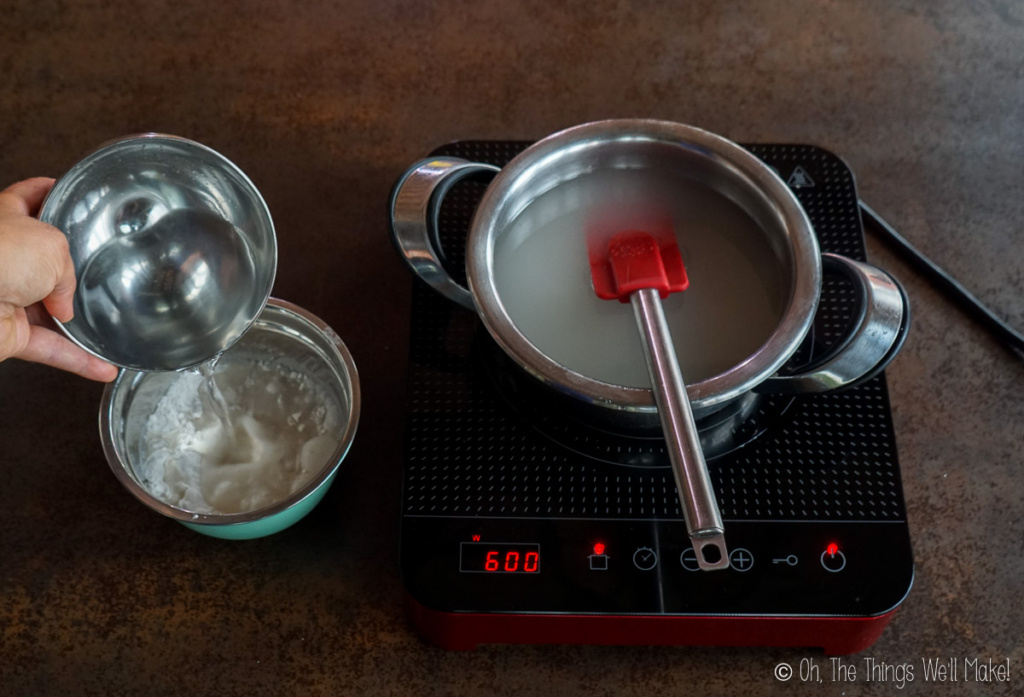
Mix starch and water. 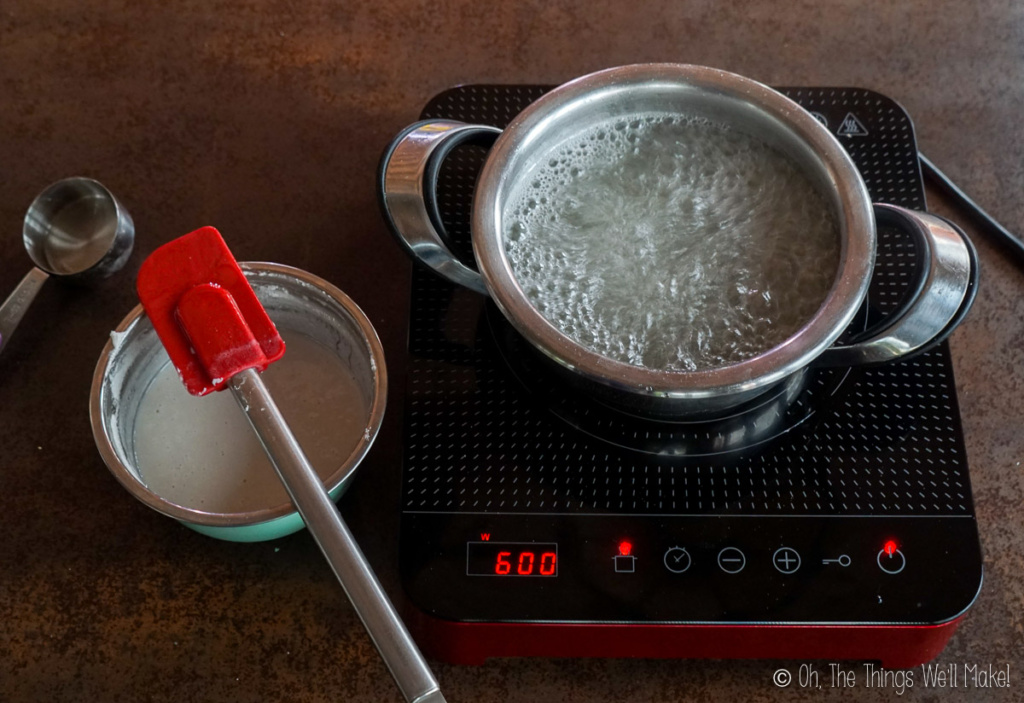
Bring sugar syrup to 140ºF. 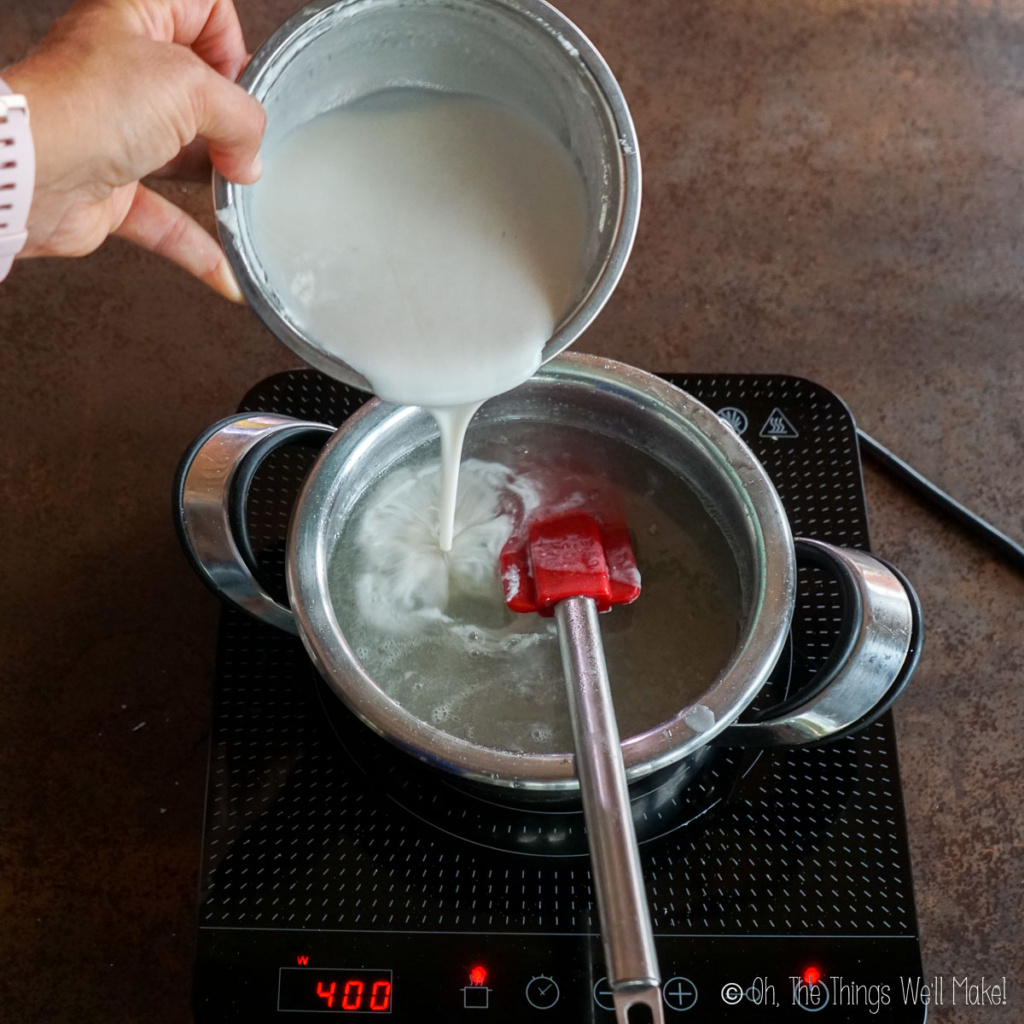
Add the starch mixture to the sugar syrup.
When the sugar syrup reaches the right temperature, take it off the heat source. Pour some of the sugar syrup into the starch solution to warm it. Then, drizzle the starch mixture into the hot sugar syrup while continuously stirring them together.
Once combined, cook the mixture over low heat, stirring constantly. It should soon get quite thick. If you have a hard time removing the lumps, you can use an immersion blender to help achieve a smooth texture.
To achieve a chewy candy, you will want to reduce and thicken it even more. That can be achieved by cooking it for quite some time over low heat until you get the desired consistency.
Check the consistency by adding some of the hot mixture to cold water to cool it. When the cooled mixture can be shaped well and hold its shape, the mixture is ready and you can pour it into the prepared mold. Spread it out as best you can with a spatula. It should be very thick and sticky.
Let cool for several hours.
Unmold the mixture onto a clean counter sprinkled with cornstarch. Cut the candy into small squares with a sharp knife, coating each of them with cornstarch to keep the candies from sticking to one another.
Preventing sticking
Most recipes call for coating the candy with powdered sugar or a combination of powdered sugar and cornstarch to prevent them from sticking to one another. The Turkish delight I bought in Turkey was only dusted with cornstarch and not with sugar. Turkish delight is already very sweet. Plus, the candy may “sweat” causing the sugar coating to “melt” off of the candy. That’s why I don’t recommend coating the candy in powdered sugar.
I recommend coating the candy with the starch you’ve used instead. If using sugar, you may have to add starch to it or reapply the coating before serving your candy.
Making Turkish delight with rice flour
You can probably guess by my introduction, that my new favorite method for making Turkish delight uses rice flour. The process is simpler, and I prefer the result. You don’t even need a candy thermometer!
To make Turkish delight with rice flour, mix together all of the ingredients in a saucepan. Whisk the ingredients together, concentrating on getting out any lumps. Cook the mixture over medium to high heat until it begins to boil. Then, lower the heat to low to medium, stirring often.
As you cook the mixture, it will get thicker and thicker. It will also turn a more golden color. When you notice it changing color and getting quite thick, turn the heat down to very low, stirring occasionally.
Check on the candy by placing some of the mixture into very cold water. When you can form it and it holds its shape, it’s ready to pour into a prepared mold. (Silicone molds can be greased with butter or oil. Other molds can be lined with a clean cloth covered with a thick layer of starch or lined with parchment paper that has been greased with oil or butter.)
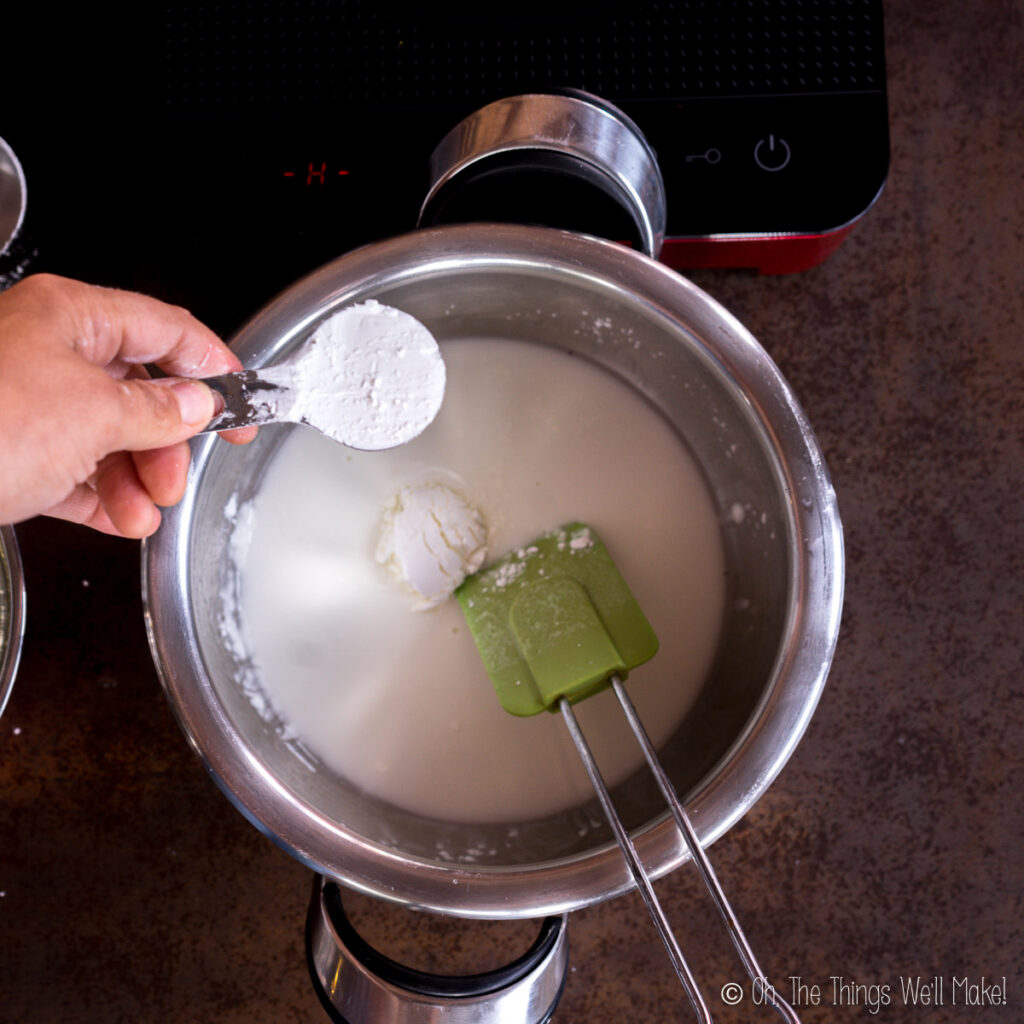
Combine all ingredients. 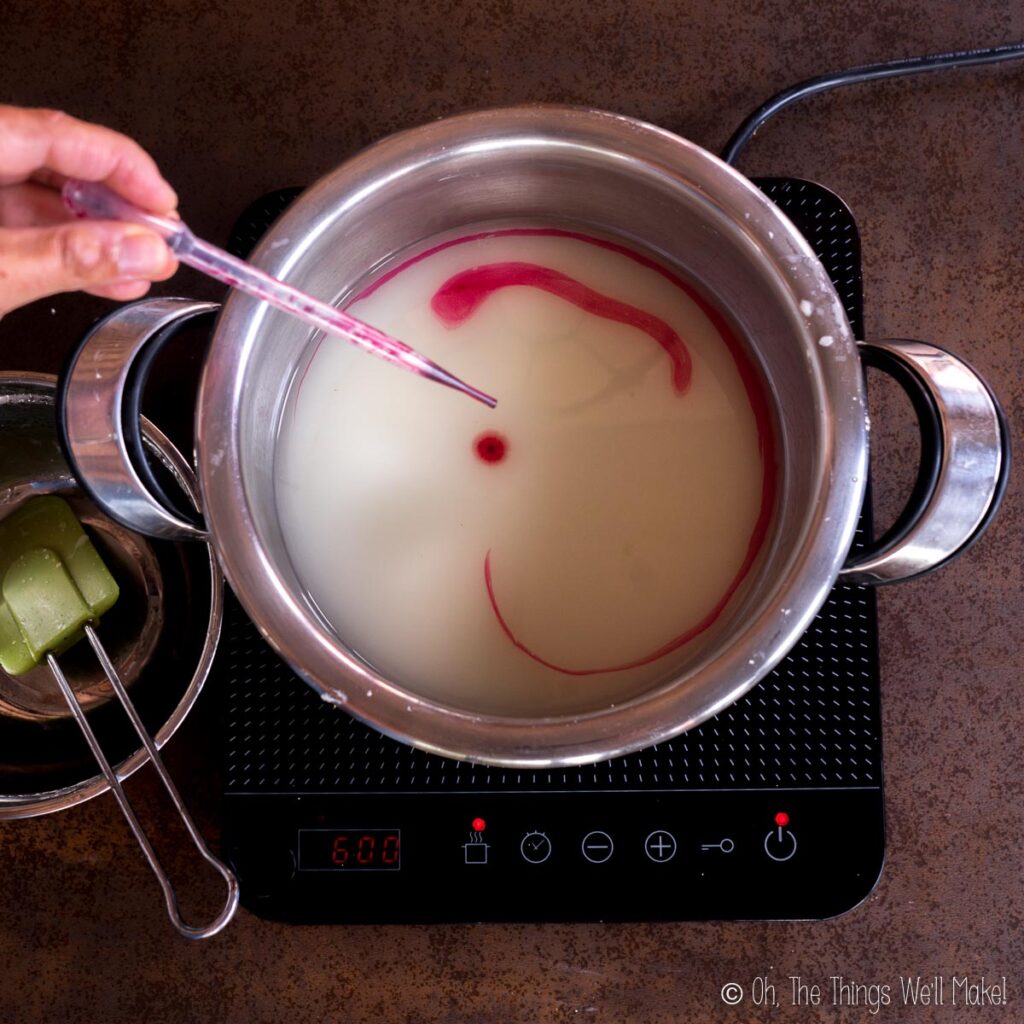
Optionally, add food coloring. 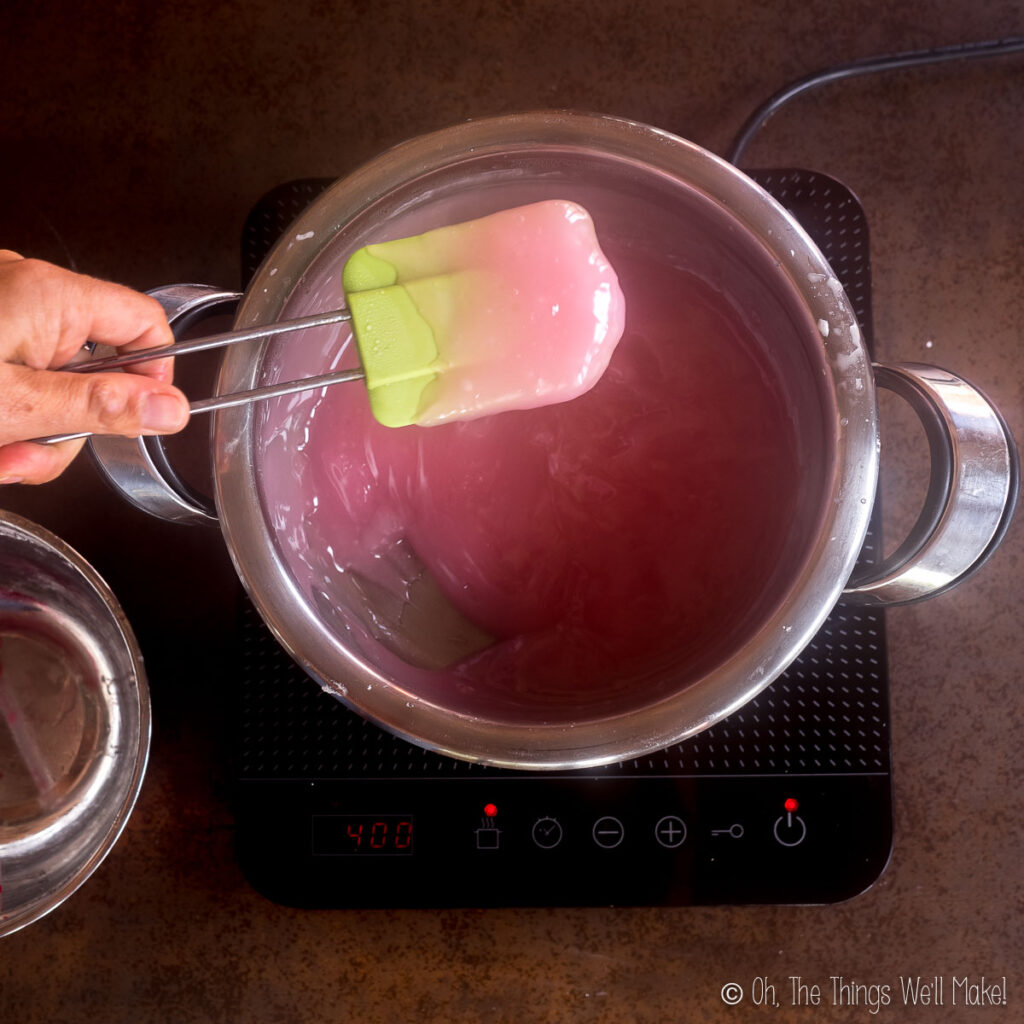
Cook until thickened. 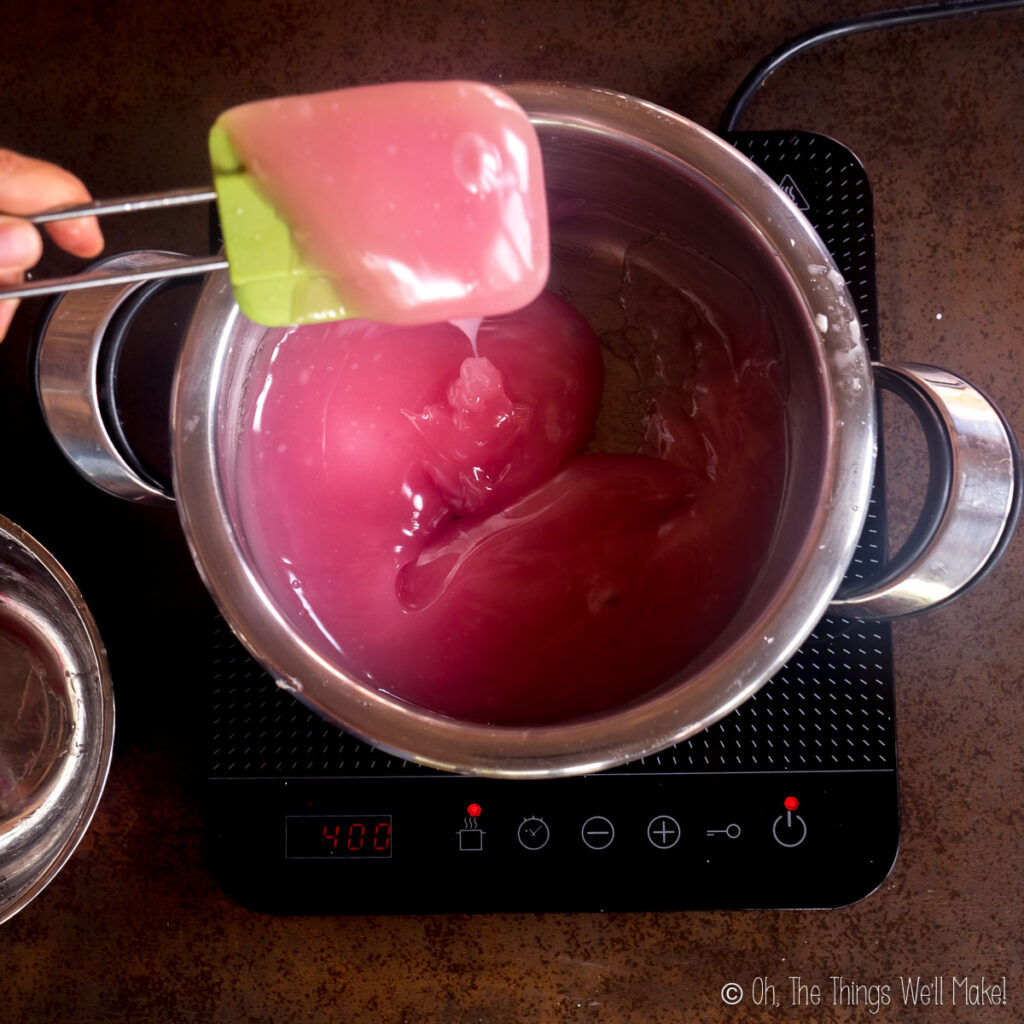
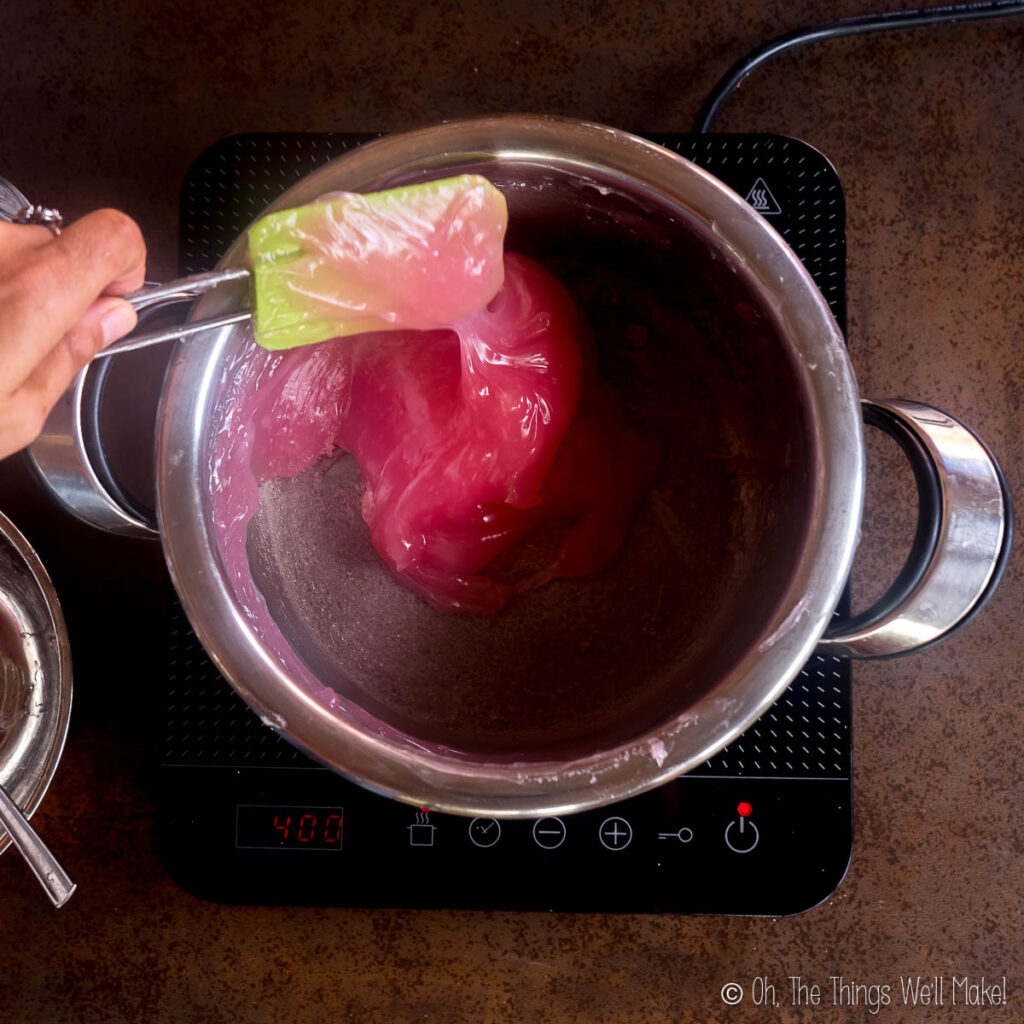
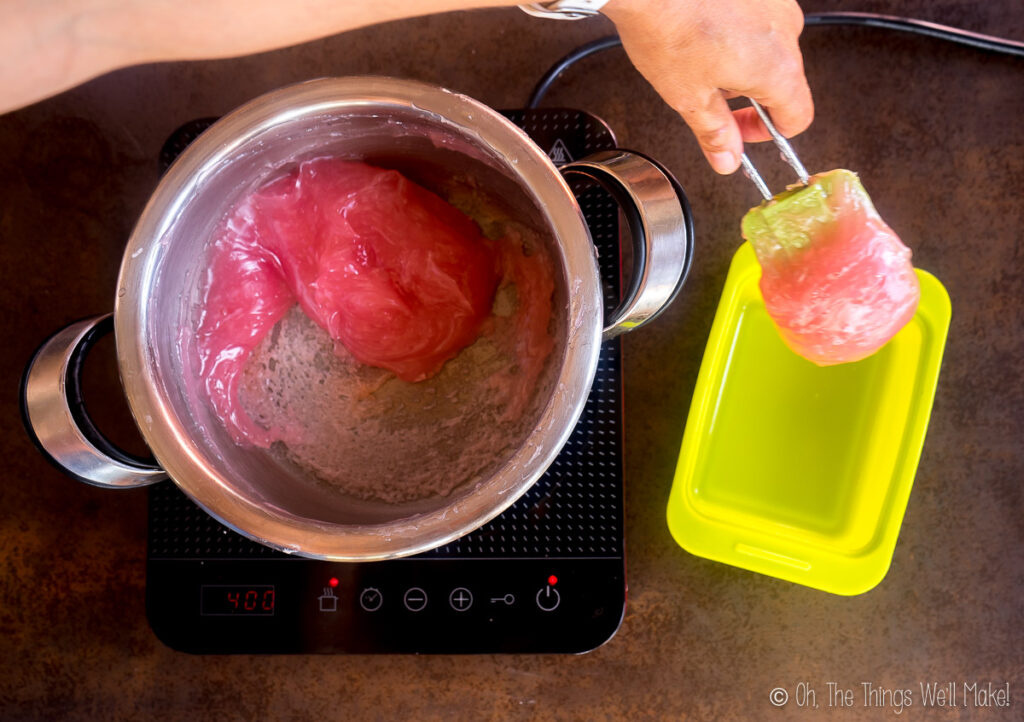
Allow the candy to fully cool before cutting into small pieces.
Troubleshooting
The trickiest part of making Turkish delight is to get the texture just right. If you don’t cook the mixture long enough to evaporate off all of the excess water, the mixture won’t be firm enough.
Some people prefer a softer Turkish delight. To obtain that, it won’t be as necessary to cook off as much moisture.
I, on the other hand, prefer the candy to have a bit of “bite”. To fix a batch of soft Turkish delight, you can reheat it and continue cooking off the excess water. You can then pour it back into the mold when you feel it’s ready.
Trying to cook off all the water, though, is easier said than done. Even on low heat, it’s easy to start caramelizing the mixture (or even burning it) when there isn’t a lot of water left. To prevent that, you should continuously stir it, but there is an easier way…
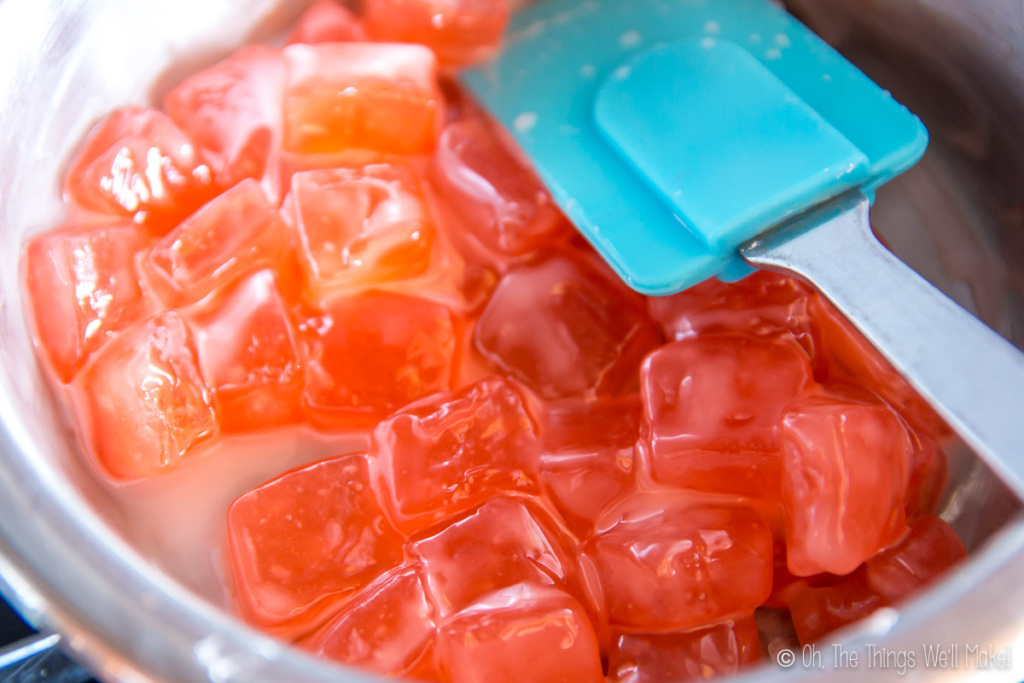
Melting Turkish delight to further cook it. 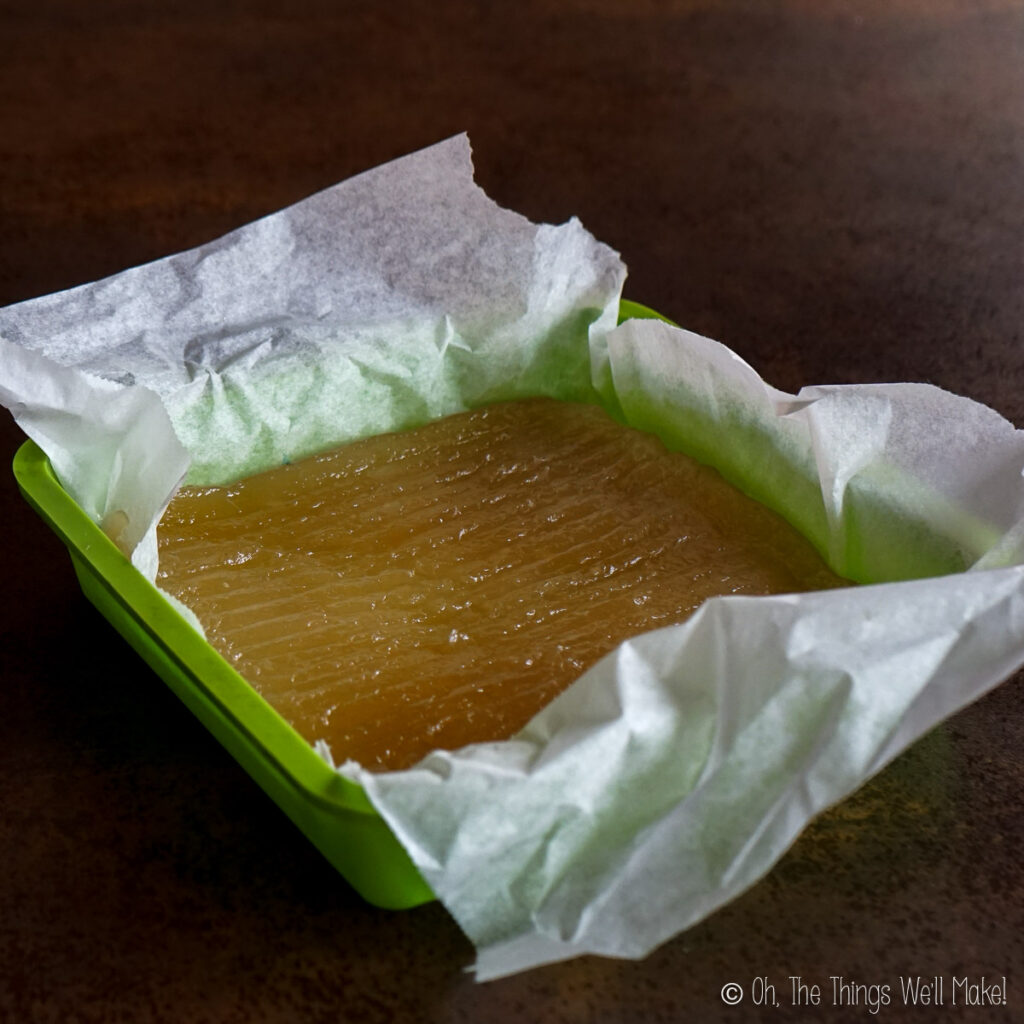
Baked Turkish delight 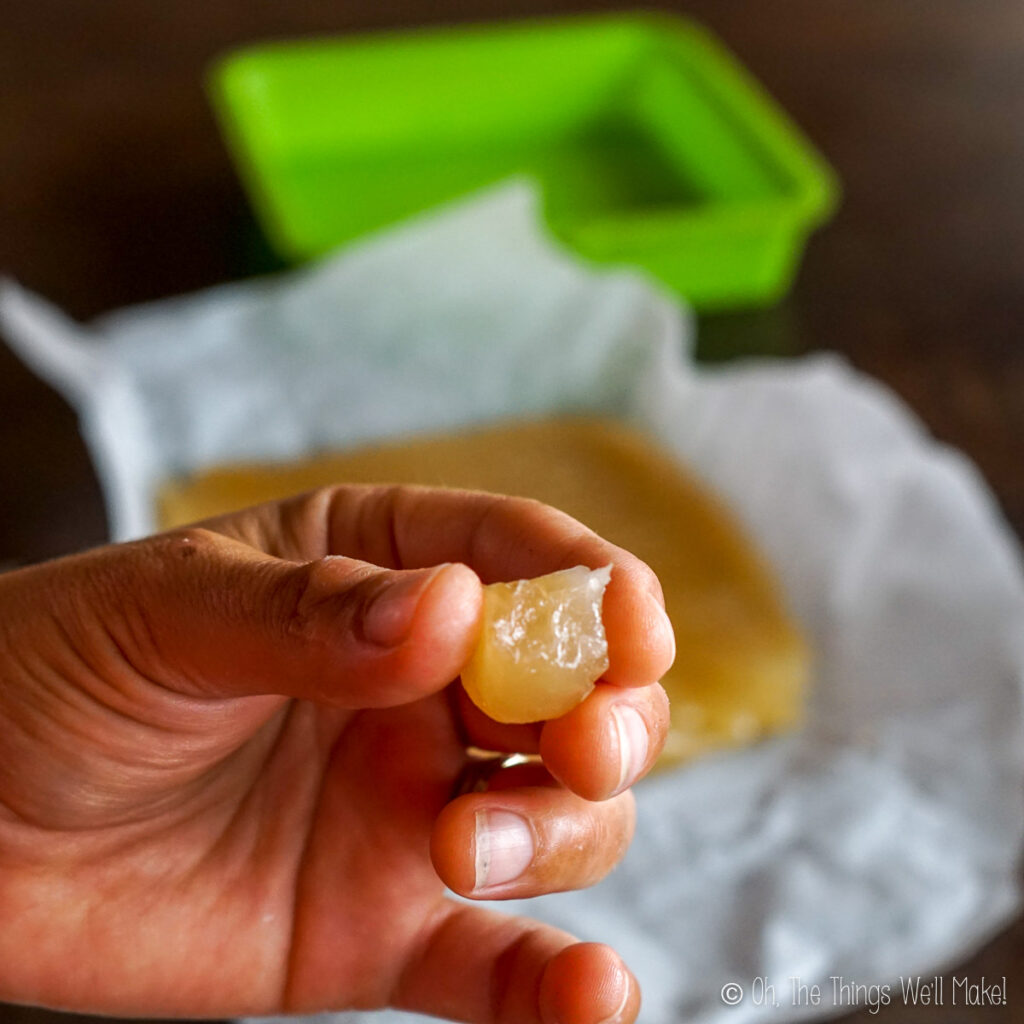
A great trick I’ve found is to bake the almost finished mixture directly in the mold! This allows you to gently heat and evaporate away the excess water without overly cooking and caramelizing the sugar! If you try this method, keep the oven at its lowest setting. (I bet a dehydrator would also work well!)
Storage
Store Turkish delight in an airtight container at room temperature, coated in starch. Because of the high sugar content and the low moisture, it is safe to eat for many weeks/months, but will lose freshness with time.
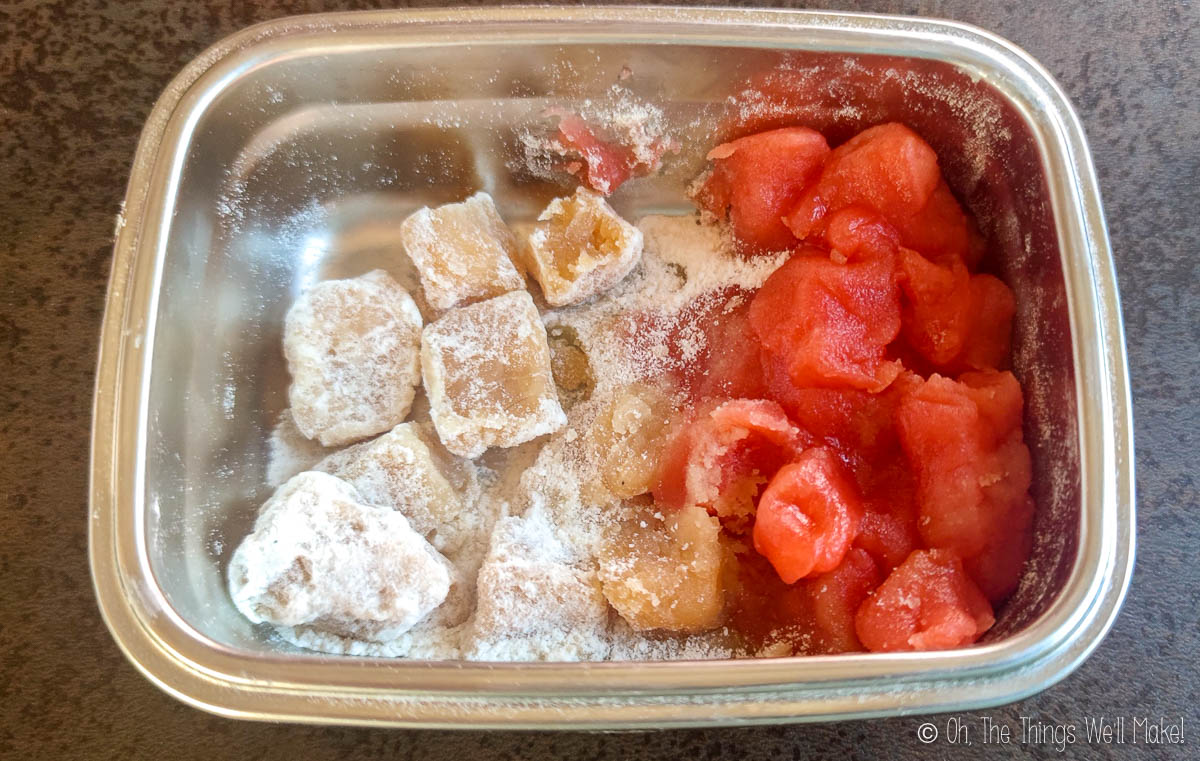
I’ve found that the Turkish delight made with cornstarch is more likely to “sweat” and become soggy with time while the one made with rice flour gets dry with time.
Video
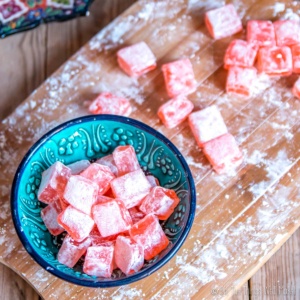
Traditional Turkish Delight Recipe (Using Cornstarch)
Ingredients
- 2 cups sugar
- ¾ cup water
- ⅛ teaspoon citric acid or lemon juice or cream of tartar
- ½ cup water
- ⅝ cup cornstarch
- Rose flavor to taste- rose water, syrup, or oil
- Red coloring (optional)
- extra cornstarch for dusting
Instructions
- Prepare your molds. I used silicone molds greased with coconut oil. If you don’t have silicone pans, line other pans with greased wax or parchment paper. (The final candy will be sticky, and that will help with the unmolding process.)
- Begin by mixing together the first 3 ingredients (sugar, 3/4 c. water, and citric acid) in a heavy bottom pan, and bring to a slight boil before lowering the heat.
- Heat, without needing to stir, over low to medium heat until you reach 260ºF. You can occasionally use a spatula to wipe down any sugar crystals from the side of the pan throughout this process.
- Meanwhile, mix together the solution of cornstarch and the remaining ½ cup of water.
- When the sugar syrup has reached the right temperature, temporarily take it off the heat source and ladle in a bit of the sugar syrup into the cornstarch mixture to warm it.
- Slowly drizzle the cornstarch mixture into the sugar syrup while continuously stirring them together.
- Once all of the cornstarch solution has been completely incorporated, begin to stir the mixture over low heat. You will notice that the mixture should get quite thick almost immediately.
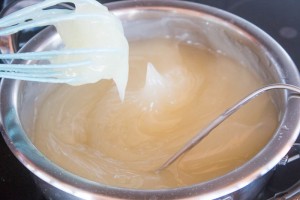
- Despite the fact that the mixture is quite thick, you will want to reduce and thicken it even more before adding in your flavorings. I found it was best to keep the mixture over a low heat so that the sugar wouldn’t caramelize on the bottom, affecting the flavor of the final product.
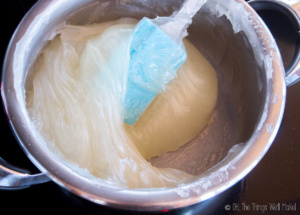
- As you heat and stir, you should notice that the gel becomes quite transparent. It will also reduce slightly in volume.
- To determine the point when you should add your flavoring, test the consistency of your candy by dipping a spoon into the gel, and then dipping the gel covered spoon into a glass of ice water. As the candy cools, you can judge the consistency and stop when you are happy with it. The longer you cook the candy at this stage, the chewier it will become and the more it will hold its shape at room temperature.
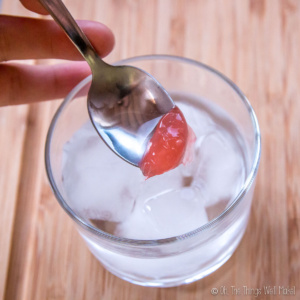
- Add in your flavorings and colorings. I wanted a strong rose flavor like the one in the turkish delight I bought in Turkey so I used a combination of 2 Tbsp. rose water, and 2 Tbsp. rose syrup. (In the first trials, I used only rose water, and it seemed to be enough for the softer versions of the candy. As you heat it more, though, the flavor gets more subtle, so I needed to add more flavor to compensate for that. You can check the flavor when you check the texture in ice water.)
- Once you’ve incorporated all of your flavorings, check the texture once more to make sure that the addition of any new liquids hasn’t affected the consistency of your candy too much. If necessary, slightly mix and warm your mixture a little longer at very low heat to help evaporate a little water, but be careful and take into account that doing this for too long can alter and diminish the flavorings you have added.
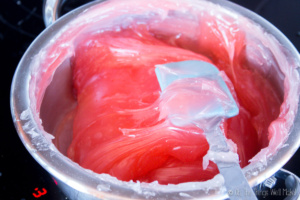
- When you are happy with your result, pour the mixture into your prepared molds and spread it out as best you can with a spatula. It should be very thick and sticky.
- Let cool for several hours.
- Cut into small squares, using cornstarch to keep the candies from sticking to one another. All of the recipes I found online either used powdered sugar or a combination of powdered sugar and cornstarch for dusting the candies, preventing them from sticking to one another. The turkish delight I bought in turkey was only dusted with cornstarch and wasn’t dusted with sugar, something I find to be unnecessary as the turkish delight is already very sweet. If you do choose to use powdered sugar for dusting, keep in mind that the candy may sweat and the sugar coating may end up “melting” off of the candy so you may have to add in more cornstarch or reapply the coating before serving your candy.
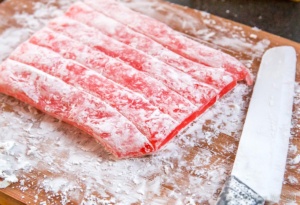

Turkish delight (Rice Flour version)
Ingredients
- 2 cups sugar
- 1 cup rice flour
- ¾ cup water
- 2 tablespoons rose water
- ⅛ teaspoon citric acid
Instructions
- Prepare a mold for the candy. Silicone molds can be greased with butter or oil. Other molds can be lined with a clean cloth covered with a thick layer of starch or lined with parchment paper that has been greased with oil or butter.
- Mix together all of the ingredients in a saucepan, whisking to remove lumps.
- Cook the mixture over medium to high heat until it begins to boil. Then, lower the heat to low to medium, stirring often.
- As you cook the mixture, it will get thicker and thicker. It will also turn a more golden color. When you notice it changing color and getting quite thick, turn the heat down to very low, stirring occasionally.
- Check on the candy by placing some of the mixture into very cold water. When you can form the cooled mixture and it holds its shape, it's ready to pour into the prepared mold.
- Allow the candy to fully cool before cutting into small pieces.
This post was originally published on July 28, 2015. It was rewritten, adding a new rice flour recipe, new photos, and improvements to the recipe instructions.
 Español
Español
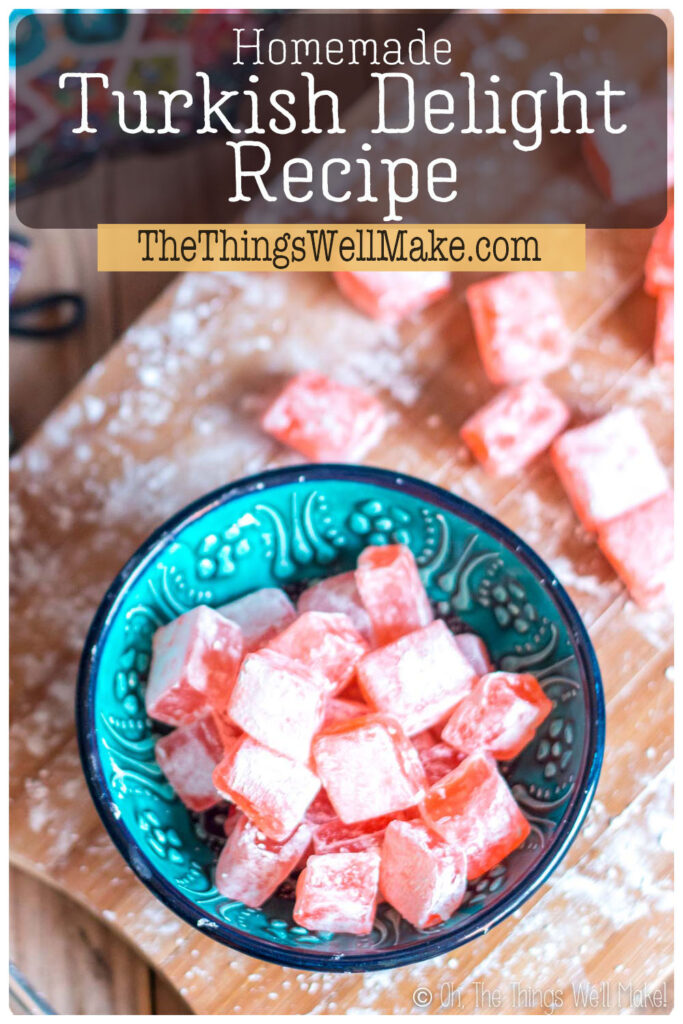
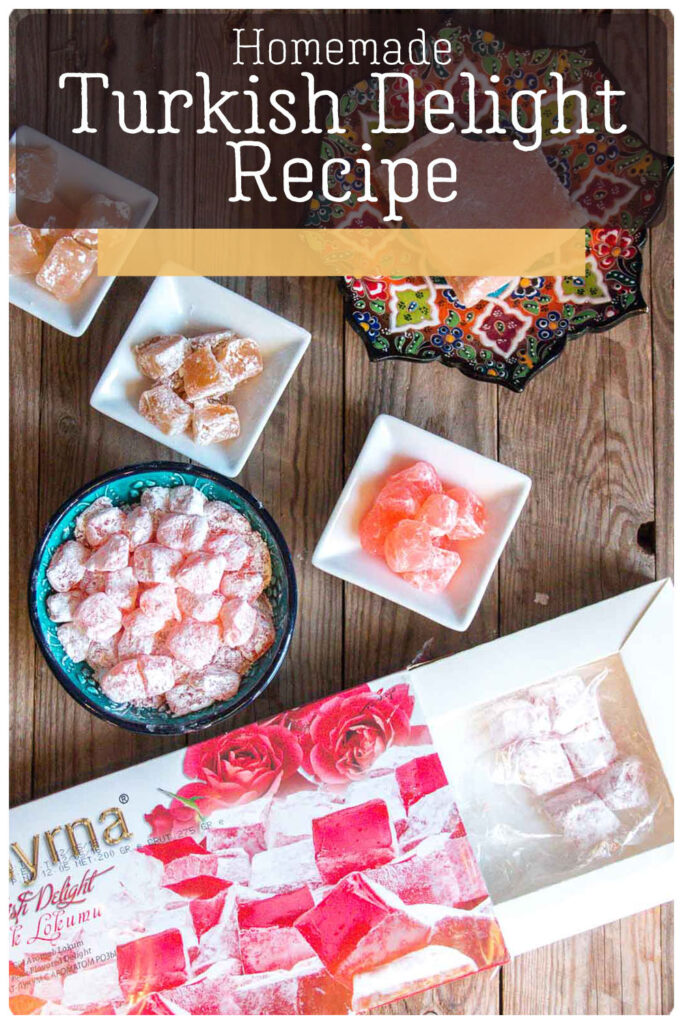
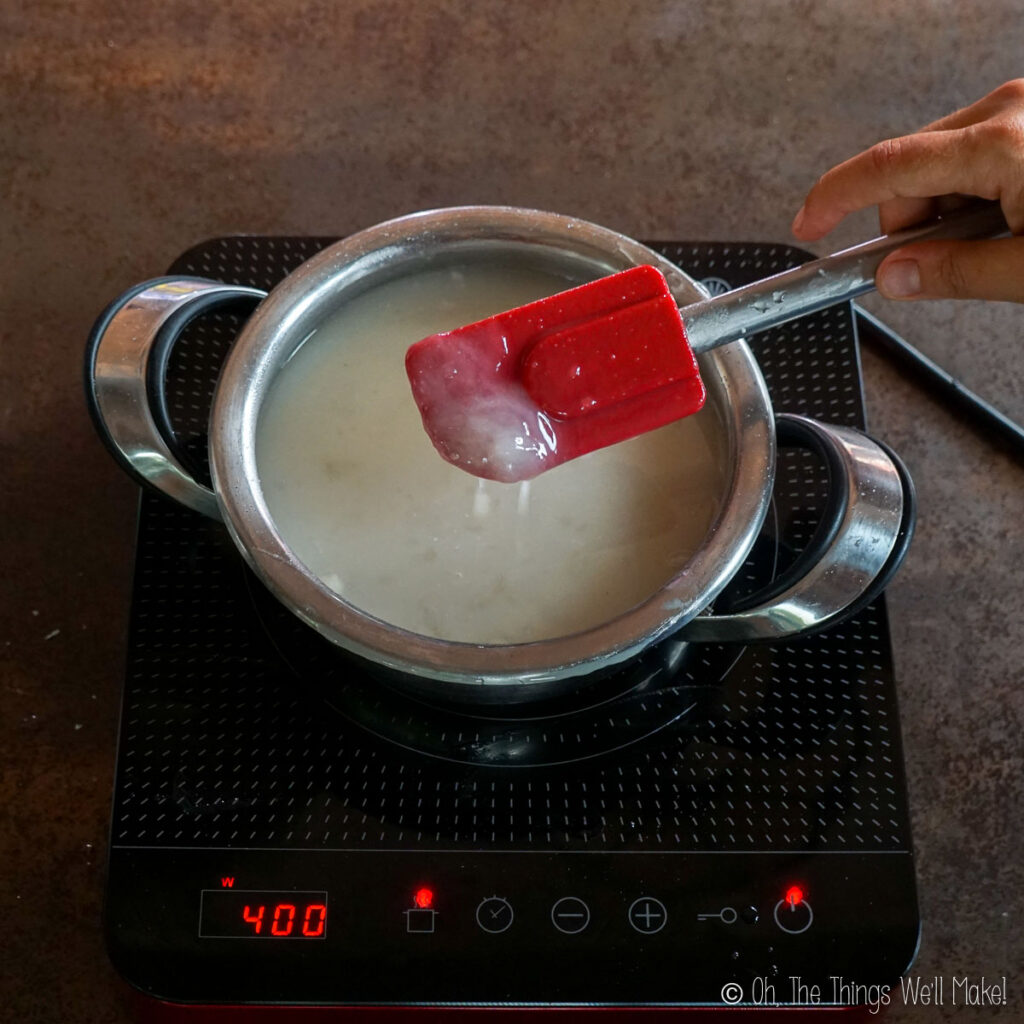
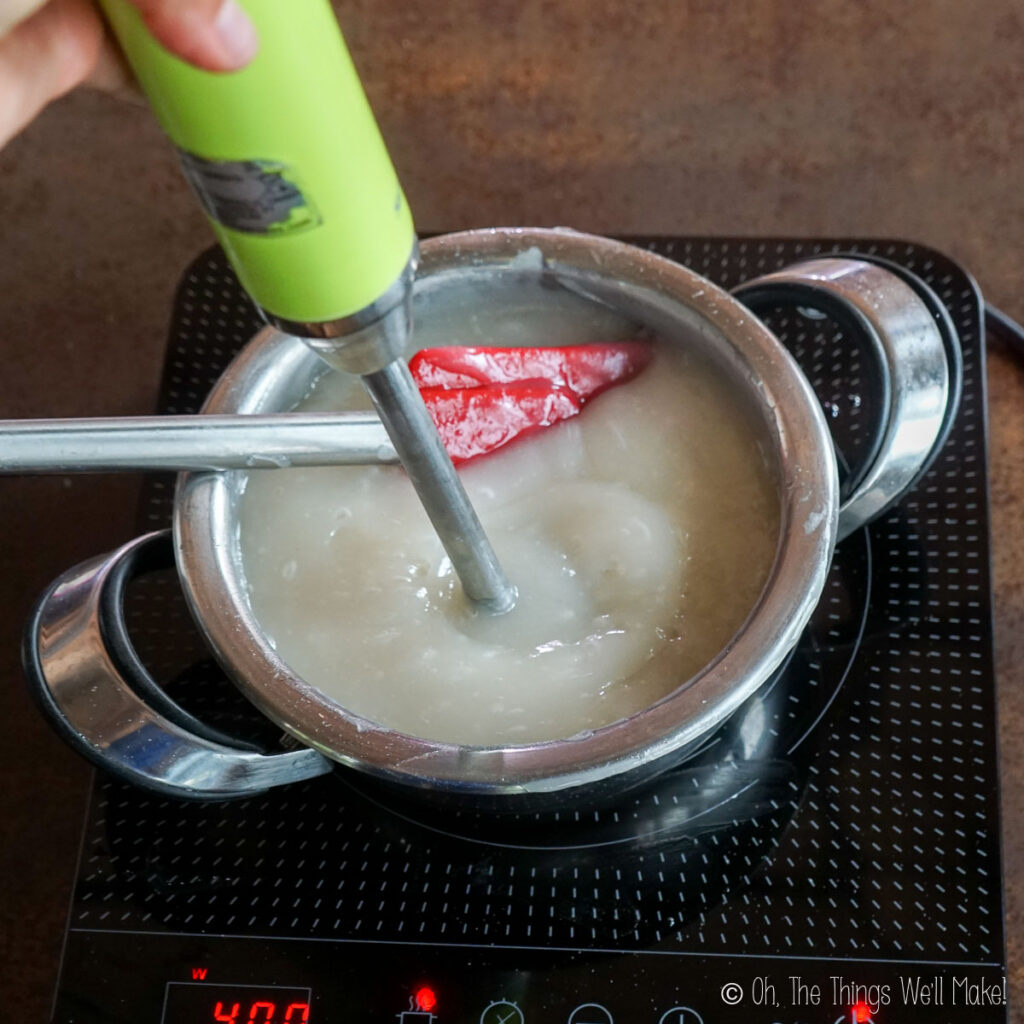
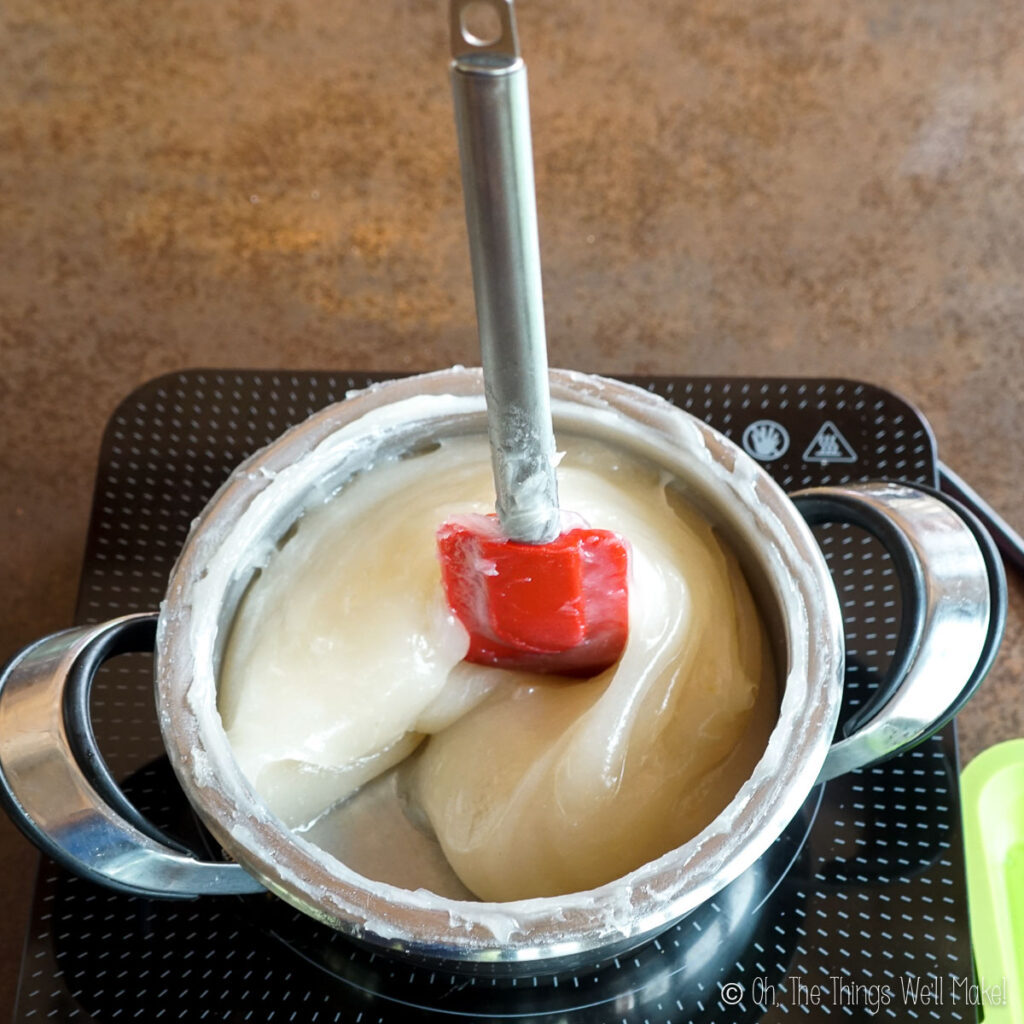
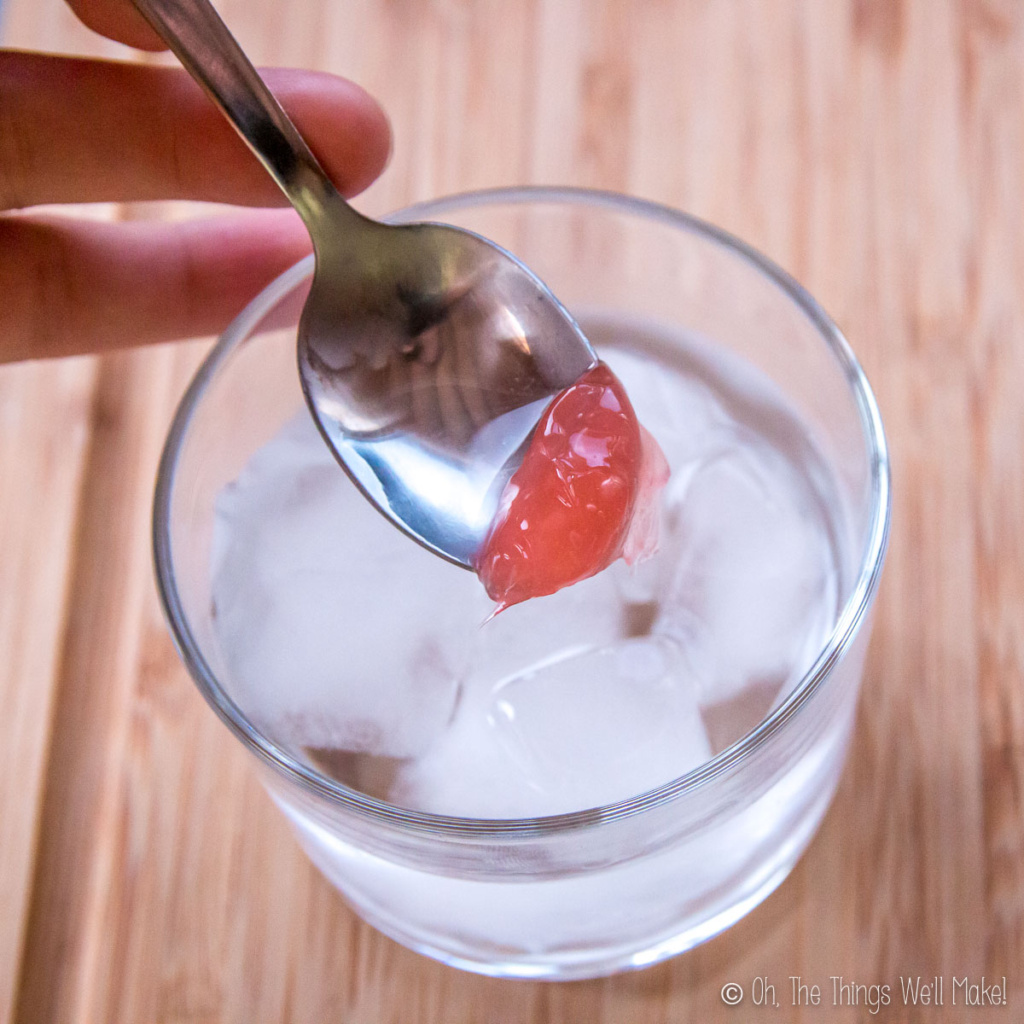
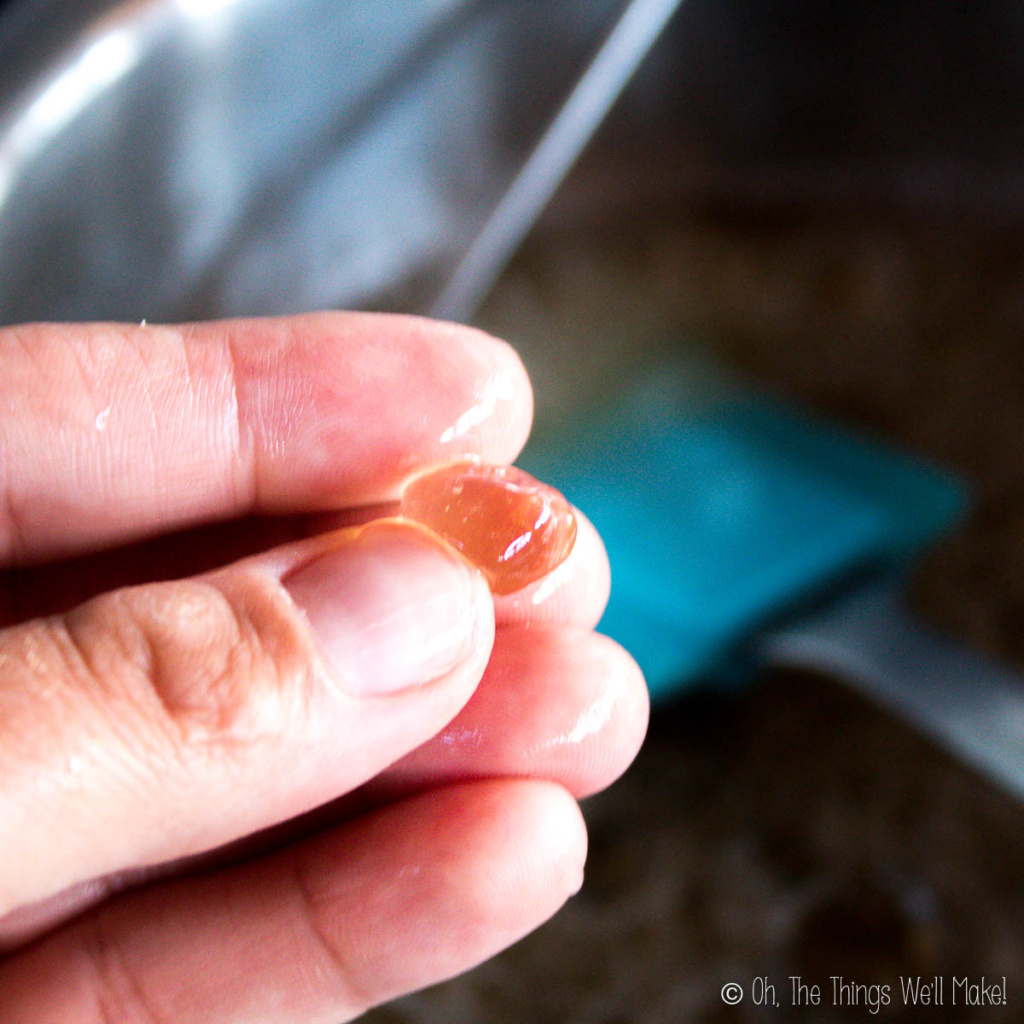
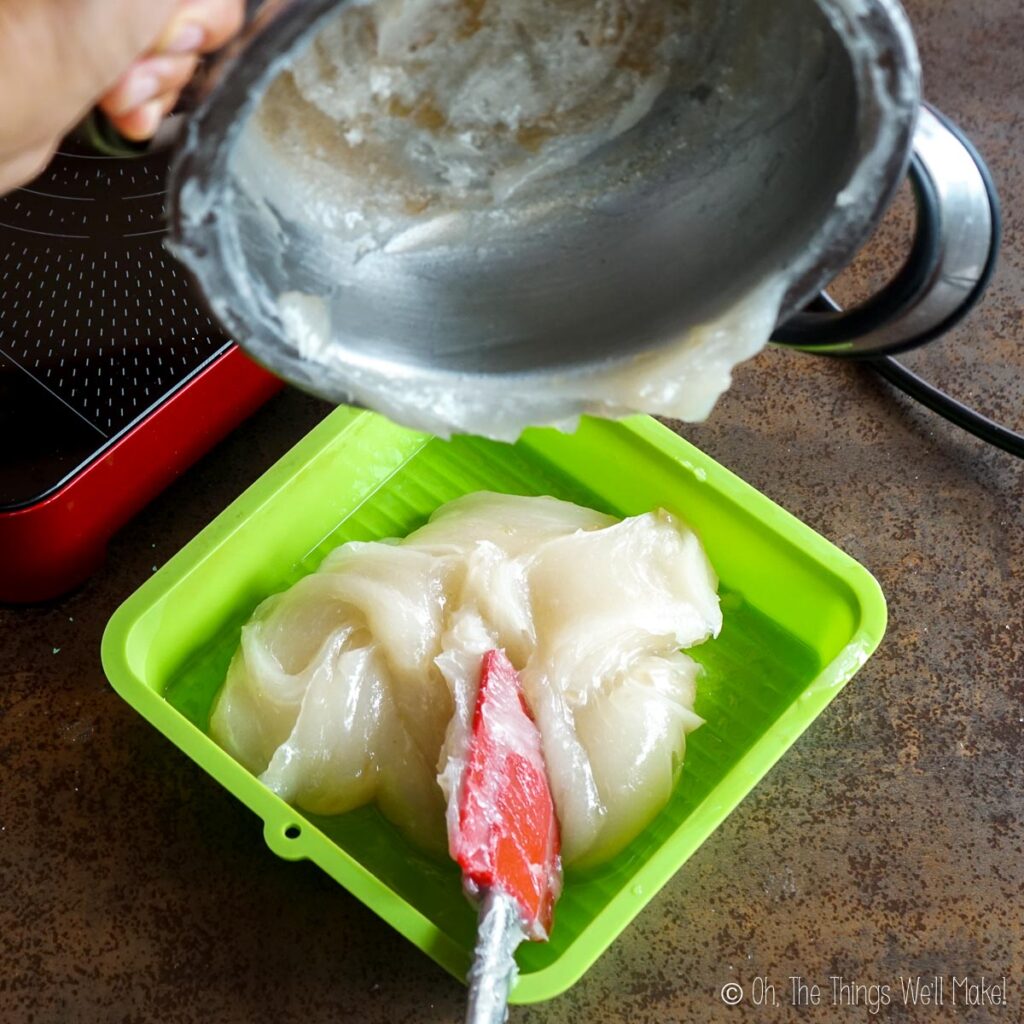
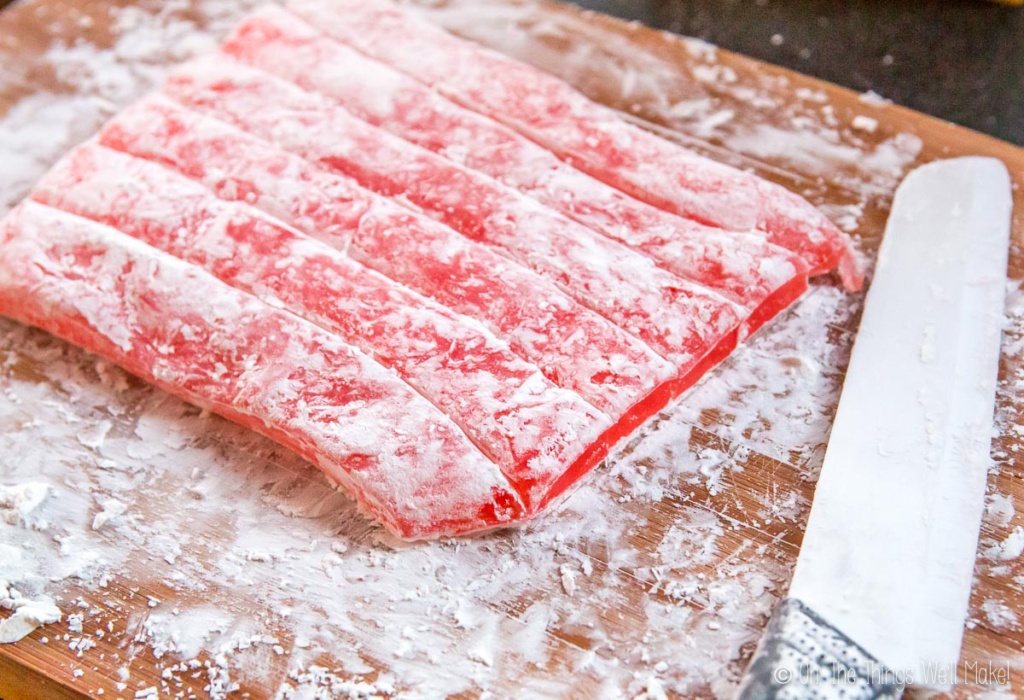
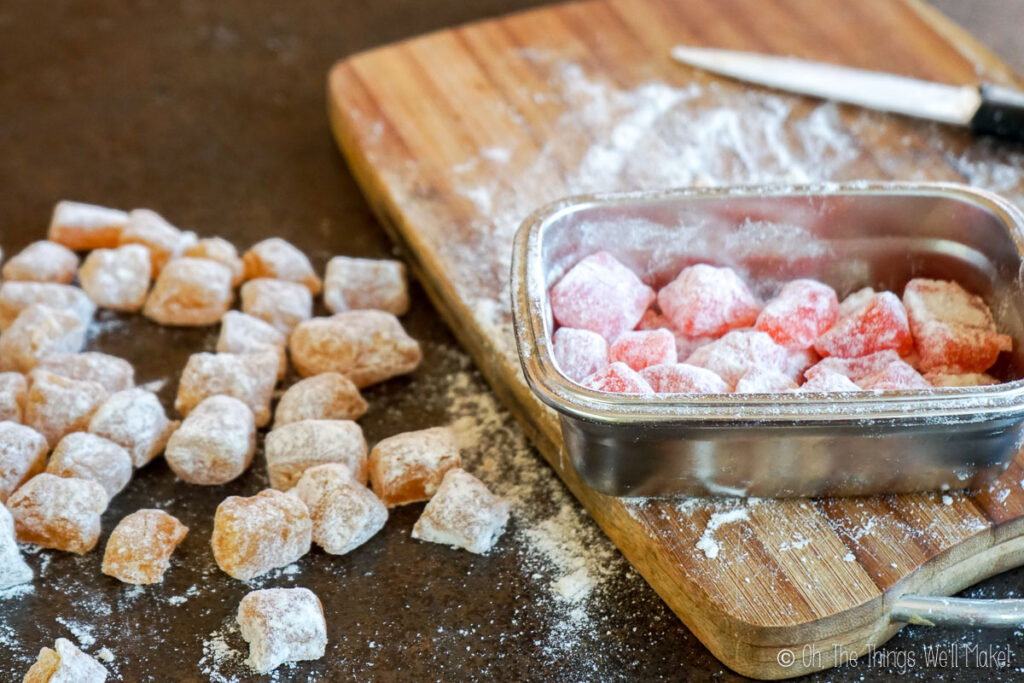
 Easy Mint Chocolate Fudge Recipe
Easy Mint Chocolate Fudge Recipe
Michelle Hoffman
Can I use arrowroot powder instead of the corn starch?
Thanks!
Tracy Ariza, DDS
Possibly, but you may need to make adjustments to the amounts and experiment. I don’t know what the final results would be as I haven’t tried with arrowroot yet!
Leon
Hi, I tried out the rice flour recipe and noticed that after a while I was waiting for the mixture to get “quite thick” (it was changing color ot deeper yellow as time goes by) it eventually crystallizes back inti sugar. I tried saving it by adding back water to dissolve it again but I think the end result will still have some crunchy bits inside, How do I fix it next time? Do I turn the heat down at the first sign of color change?
Tracy Ariza, DDS
I didn’t have that issue, but, yes, I’d definitely avoid getting any dark areas as that means that part of the batch is getting too hot and will get hard. Try to mix and/or lower the heat as needed.
MK
The only thing I’d note after several experimental rounds of making turkish delight in past years is that I don’t use starches to dust them off afterward. As noted, they tend to sweat a lot and I found using starch always turns them into sludge after a few days – although I’ve never made them with rice flour before which may perhaps solve this. Whatever the case, I typically will roll them in desiccated coconut, and in shops I’ve also seen things like powdered nuts and dried hibiscus used for the same purpose. These obviously won’t dissolve and will give some additional flavour/texture to the turkish delight which you won’t get with just starch.
Tracy Ariza, DDS
Yes, that sounds like a great solution!
Using powdered sugar is the worst option, in my opinion,but seems to be the most common.
I love using dessicated coconut for the same reason when making homemade marshmallows.
Kacey
What a great article, thank you for summarizing your experiments and thought process. I have been trying to perfect a chewy candy recipe and had many fails with gelatin and pectin. I tried your updated “easy” process, but used tapioca flour instead. For flavor I used 2 tsp of LorAnn flavor oil and 2 tsp of citric acid to make the candy tart. It worked great, exactly what I have been aiming for! I agree it is much easier to whisk and boil all of the ingredients together at once.
I did use a thermometer for my own experimentation. I poured out about a cup of the mix each at 240 F, 250 F, 260 F, and 280 F. I am at very high elevation so water boiling point is 12 degrees lower for me vs. sea level, so this was varying degrees of hard ball and soft crack stages. I think 260 F worked best for me, the lower temps flattened and lost their shape overnight, and the higher temp basically turned into hard candy. All of them are delicious, though!
Tracy Ariza, DDS
Interesting! Thanks so much for your feedback! I love tapioca flour, so I’m glad to hear it works using it!
Sally
Hello!
The recipe seemed great, very specific and scientific, but my mixture had serious issues thickening. I followed the instructions verbatim, making sure all the temperatures were precise, and my mixture never thickened. The first time it happened I had substituted half the cornstarch for flour, so I assumed that when it didn’t work it was probably because of that substitution. I cleaned everything up and tried again with the full amount of corn starch and the mixture didn’t thicken agains. Both times I continued to stir it on heat hoping it would eventually thicken for about 20 minutes. What did I do wrong?
Tracy Ariza, DDS
Hi Sally,
I wish I could be more help.
This recipe had always thickened for me, no matter what starches I’ve tried, so I’m always at a loss as to what the promise when people can’t get it to thicken.
That said, even when I make it in the exact same way with the exact same ingredients, the texture (and even the flavor) changes from batch to batch.
Humidity, ambient temperature, etc.seem to really affect the recipe, making it very finicky and frustrating.
I’ve worked hard over the years trying to get a reproducible recipe that is constant from batch to batch, but I can’t say I’ve been able to achieve that.
SR
Thanks for sharing the results of your candy-making trials!
Rice flour is an interesting idea. I’m going to have to try that.
There is some reason to combine the cream of tartar with the cornstarch. Turkish delight depends on the gel that forms when the cornstarch and water are heated together. However, that gel is a non-Newtonian fluid that both resists combining with another fluid (the sugar syrup) the more it’s stirred and breaks down if it’s heated for too long. Interacting with acids in the sugar syrup and in the starch/water mixture forces the cornstarch to take on water from both, allowing the two liquids to come together more easily than they might otherwise do. It’s a VERY delicate balance to strike, though: too much acid, too much heat, and stirring too vigorously can each undo the gel.
At the end of the day, it’s really a matter of what works best for the cook.
Tracy Ariza, DDS
Thanks for that information!
Yes, I’ve found it’s very delicate and tricky. I’ve made the same recipe in the same kitchen since then, and while it always thickens for me, the results can be quite different each time. It’s very frustrating!
Mac
There are 3 measurements for water. Step 4 (cornflour receipt) doesn’t say how much to add. Confusing recipe.
Tracy Ariza, DDS
The water measurements are with their corresponding ingredients. You use the half cup of water as written with the cornstarch.
Bilal
Hi Tracy.
I tried the rice flour recipe and unfortunately my result was pretty doughy and like mochi. Do you know what I could be doing wrong?
Tracy Ariza, DDS
Hi Bilal,
A soft texture generally means it needs to be cooked longer to dry it more and make it a more consistent texture.
Teddy Chef
Hey there Tracey!
Thanks for this, so much!!
The texture with the rice version had the firmness I have been looking for though I found it gritty (not sure why -any ideas?), but I am wondering … cornstarch provides a ‘clarity’ in the candy that rice flour does not – it remains cloudy – and I am curious if any other starches you experimented with also give the TD a similar ‘clarity’?
Let me know your thoughts!
Thanks
Teddy
Tracy Ariza, DDS
Hello!
I stopped experimenting, but did want to try tapioca starch at some point. It’s what is used to make boba (for bubble tea) ad they get thick and transparent, so my guess is that it would work well.
If you give it a try, I’d love to hear how it goes. I’ve been avoiding sugar these days. 😉
Carolyn
Are you using sweet white rice flour or glutinous rice flour?
Thank you
Tracy Ariza, DDS
Hi Carolyn,
I used a regular (not glutinous) rice flour, but it would be interesting to give the other a try as I suspect it may give a good result.